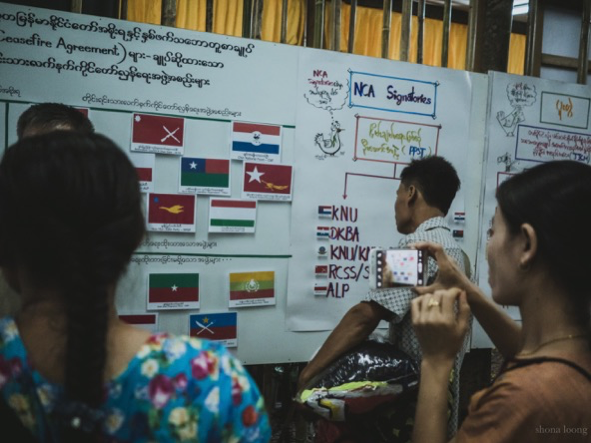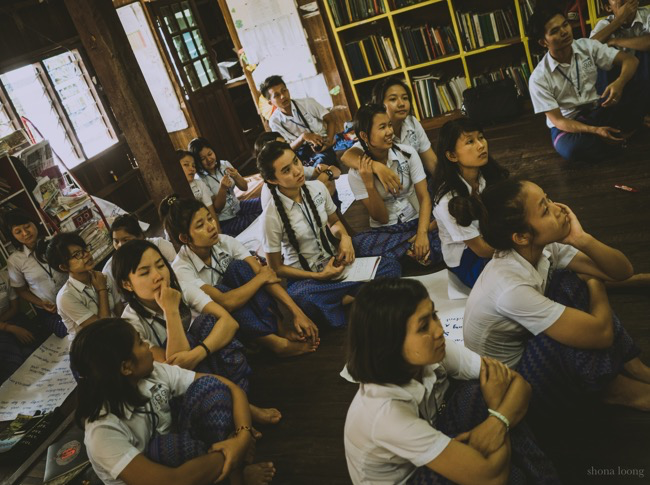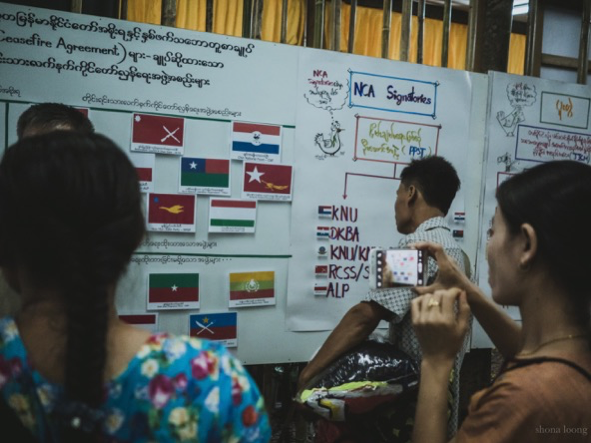
Shona Loong uses world histories of anti-colonial nationalism to reexamine the Karen struggle.
Decolonization, we are often told, transformed a world of empires into a world of nation-states. Between the 1940s and 1960s, amid an efflorescence of anticolonial nationalist movements, dozens of new states were formed. Among the leaders of these movements were some who would become state symbols: Nyerere of Tanzania, Nkrumah of Ghana, Nehru of India, and Aung San of Burma. Yet, by telling history according to the exploits of statesmen, we risk conflating the movement for decolonization and the struggle for independence. As various world historians and political theorists have shown, decolonization was a much broader project than nation-building.
Adom Getachew, for instance, argues that we should understand decolonization as worldmaking; a means by which colonized peoples experiment with political forms in order to challenge the structures of domination experienced over centuries.[1] Getachew argues that these political forms often transcend the nation-state, as with intellectuals of the Black Atlantic that conceived of pan-Africanism in the first half of the 20th century.[2] Even when many of these intellectuals eventually became statesmen and national heroes, such as Kwame Nkrumah (Ghana), Julius Nyerere (Tanzania), and Eric Williams (Trinidad and Tobago), they continued to promote solidarity among African states as a response to their shared experiences of oppression. They did not see decolonization as “finished” at independence but rather as a ‘project of reordering the world that sought to create a domination-free and egalitarian international order.’[3]
There were also anticolonial nationalists who never became heads of state. These individuals are the focus of Lydia Walker’s work, which examines ‘minority nationalisms’, or nationalisms that have not become instated in the form of the nation state.[4] Walker demonstrates that minority nationalists used transnational networks to carve out spaces for themselves in a changing world order. This was the case of the Nagas. Although the Naga were not granted a separate state at Indian independence, their claims to nationhood gained traction among a wider international community as a result of their close affinity with Christianity.[5] Unfortunately, the influence of many minority nationalists waned in later years due to the emergence of state-centric institutions such as the United Nations.[6] Even so, Walker’s work reminds us that national independence was not the predetermined endpoint of movements for decolonization. Alternative political forms were possible thanks to the arduous work of many leaders who never inherited a nation-state congruent with their aspirations.
Hence, decolonization is an ever-present force against colonial power relations, that must be understood as analytically separate from processes of nation- or state-building In the words of Arturo Escobar, this perspective sees the world as comprised by ‘two parallel processes: the systemic suppression of subordinated cultures and knowledges’ and the ‘necessary emergence, in the very encounter, of particular knowledges shaped by these experiences that have at least the potential to become the sites of alternative projects.’[7]
Unequal power relations thus always coexist alongside countervailing decolonial forces. Furthermore, worldmaking refers to a practice by which people draw on existing symbolic and material resources, to create new symbolic systems.[8] Decolonizers make worlds when they produce alternative political forms to challenge dominant power relations.
Indeed, experiences of decolonial worldmaking are as widespread as the postcolonial world itself.[9] Getachew, Walker, and Escobar’s reference points span the Black Atlantic, Latin America, and Southern Africa. Yet, the struggles of the Karen and other ethnic groups in Burma/Myanmar have hardly been seen through this lens. One wonders if this is because of exceptionalism on two counts: the tendency to see Burma/Myanmar as somehow inscrutable in comparison with other nation-states, and the tendency to discount the political activities of non-Bamar groups as an “ethnic” struggle, without recourse to larger political goals.
Hence, this essay uses the concept of decolonial worldmaking to reinterpret ethnic politics in Burma/Myanmar. I am particularly interested in the Karen struggle, which shares some similarities with Naga nationalism, such as the links between the nationalist elite and Christian missionaries, and the use of international platforms to surpass a lack of recognition at the nation-state level. I start by comparing a Bamar-centric account of decolonization in Burma with an account of decolonization told from a Karen perspective. This shows that the Bamar-centric narrative that traces Burma’s transition from colony to nation-state may sideline the means by which other groups were challenging colonial authority. Then, I consider three ways in which decolonial worldmaking offers a rereading of the Karen struggle. Finally, I conclude with the relevance of these debates for present-day understandings of the Karen struggle as an “insurgency” or as a fight for “federalism.”
If we conceive of decolonization as a transition from colony to nation-state, the vanguards of decolonization in Burma would be the individuals and institutions at the forefront of the incipient nation-state. This leads to a Bamar-centric account of decolonization that foregrounds the actions of Aung San, U Nu, the Anti-Fascist People’s Freedom League (AFPFL), and the Burma Independence Army, at the expense of other actors that were struggling for political autonomy during the 1940s to 1960s.
A Bamar-centric primer on Burma’s independence might read like this: beginning with the first Anglo-Burmese War (1824-1826), the British replaced indigenous institutions with unfamiliar administrative machinery.[10] Over a century of colonial rule, the social and political structures of the Court of Ava were dismantled, and in its place, the colonial bureaucracy imposed an ‘order without meaning.’[11] In the 1930s, many who were dispossessed and disgruntled by colonial rule organized within the nationalist group, Dobama Asiayone. The nationalists fought alongside the Japanese during World War II, believing that they would be rewarded with independence. However, their hopes dashed, they turned against the Japanese in 1945, helping the Allied powers to drive the Japanese out of Rangoon. The nationalists—now organized as the AFPFL—negotiated with the British once the war was over. In 1947, Burma emerged as an independent nation-state. Until recently, this narrative, which positions Aung San as a unifier of Burma on par with past kings, has been repeated in classrooms and textbooks throughout Myanmar.
Consequently, armed struggles waged by the Communist Party of Burma and several ethnic armed organisations are often blamed for derailing the nation-state’s upwards trajectory.[13]
A Karen primer on the latter might read as follows: the Karen were first to arrive in what is now considered Burma/Myanmar. They lived in freedom for two hundred years, until Mon and Burman kingdoms encroached on their areas.[14] The British defeat of the Court of Ava provided them with a respite from their subjugation. To counter their fears of marginalization from decision-making processes in British Burma, the Karen organized amongst themselves.[15]A group of Sgaw Baptists formed in the Karen National Association (KNA) in Rangoon in 1881, the precursor to the KNU. In 1928, the KNA proposed the formation of an independent Karen state in the aftermath of British rule. They attempted to secure autonomy by various means, including making appeals to the British, the Burmese government, and considered doing so to the United Nations.[16] However, the Karen were excluded from independence negotiations, including the renowned 1947 Panglong Conference.[17] In 1947, despite their varying positions vis-à-vis the AFPFL,[18] the KNA merged with other fledgling Karen organisations to form the KNU. Only in 1949, after communal violence between Bamar and Karen populations, did the KNU initiate their armed rebellion. The rebellion lasted more than sixty years; even today, ceasefires between the KNU and the Myanmar government have not resulted in a satisfactory solution to Karen demands for autonomy and freedom.
Bamar-centric narratives of history thus frame Burma’s postcolonial history in terms of a transition from empire to an independent nation-state, providing only a partial account of decolonization. These narratives position the struggles of groups like the Karen as second-order to the “main” struggle waged by Bamar anticolonial nationalists, even though the Karen were engaged in their own attempts to challenge domination by both the British and the Bamar majority. Why have the Karen—and other non-Bamar groups—been left out of scholarly understandings of decolonization? If the nation-state was not predetermined, what other political templates might Karen groups have pursued to allay their grievances? How might the present look different, had subaltern actors been able to venture down these roads-not-taken?
Whereas scholars credit Burman nationalists for drumming up anti-colonial sentiment,[19] scholars tend to portray the Karen as having a more ambivalent relationship with British rule. For one, scholars contend that the Karen comprise people from diverse linguistic, religious, and cultural backgrounds, who were only classified under a single category during British colonization.[20]
Scholars also argue that the Karen—or at least the Christian, Sgaw elite within this population—benefitted from American missionaries’ incursions into the hills,[21] as missionization provided the Karen with a literate tradition,[22] access to Western knowledge, and links with the wider world. As with members of other non-Bamar groups, Karen individuals were also incorporated into the colonial security apparatus as policemen, soldiers, and bureaucrats, in positions denied to the Bamar.
Still, the legacies of colonialism and missionization were a mixed bag. By creating an Anglophone, Christian elite, colonization sidelined those within the Karen who were Buddhist, Pwo,[23] or otherwise lower on the social hierarchy.[24] The KNU continues to struggle with reconciling such internal differences within visions of Karen unity today.[25] Moreover, there is the sticky historical fact that the British did not recognise Karen claims for independence. Having fought for the British during WWII, many among the Sgaw Karen elite believed that they would be granted an independent state as a reward for their service. However, the British ultimately recognized the AFPFL, not Karen nationalists, as front men in negotiations about the Burma question.[26] Up until the departure of the British, Martin Smith writes, ‘petitions from Karen communities, still trusting in the protection of British rule, continued to pour into the colonial government. Today they are forgotten, simply gathering dust on the shelves of the India Office in London.’[27] Colonization bequeathed the Karen with an ethnicity, but not a state.
I am struck by how often Karen claims to nationhood are described as “forgotten”, even today. Western media outlets often describe the Karen as forgotten WWII veterans and as part of a forgotten story. Words like these give the impression that the tide of history simply passed the Karen over. While there is truth to the claim that desire for a quick settlement drove the British to bypass Karen nationalists, this gives short shrift to Karen nationalists, who were actively organizing among themselves. The description of the Karen as forgotten—and thus as passive—is related to other historical descriptions of Karen ethnicity. The Karen are often described as “loyal” to the British, and thus as lacking the kind of anticolonial fervour embodied by the Bamar population. However, it is important not to take this description at face value. After all, this descriptor originated with the colonial officer Smeaton, rather than Karen representatives themselves.[28]
One wonders if what was read as “loyalty” to the British might have been a considered strategy on the part of Karen leaders, who were cognizant of the Karens’ distinctive contributions to the colonial state. Indeed, the Karen rebellion is hardly static, but has evolved with every generation and in relation to new challenges at the national, regional, and global level. Brenner, for instance, explains how the Karen rebellion has transformed according to various KNU factions’ relationships with the Karen people they seek to represent.[29] My own research shows how, at various points, the waxing and waning of Karen civil society organisations affects this struggle, in relation to the actions of rebel groups and development actors.
Instead of seeing Karen nationalists as “forgotten” or “loyal”, I wonder how we might reread the Karen struggle as decolonial worldmaking. Not only does this better acknowledge the agency of Karen leaders in the 1940s, it also has salience for the present day. Understanding independence as the endpoint of decolonisation implies that the Bamar narrative of independence was anticolonial nationalism “done right,” and the Karen struggle as its antithesis. Instead, decolonial worldmaking provides an alternative vocabulary for understanding what the Karen are doing under the remit of struggle, rather than what was not accomplished, while taking into account the ambivalences of Karen ethnicity.
Firstly, if decolonial worldmaking emerges ‘from the very encounter’ between dominant and subordinated peoples, projects of decolonial worldmaking do not need to stand apart from the power relations engendered by colonization to qualify as such. Most of the Karen colonial bureaucrats who became proponents of Karen nationalism were male and part of a colonial elite, such as Theodore Thanbyah and Saw Aung Hla, as with other anticolonial movements.[31] They appropriated the networks and resources they accrued from their relationships with the colonizers to work towards their own goals.
However, that the Karen were granted preferential treatment by the British does not blunt the nature of their struggles for recognition and autonomy, it merely reveals that decolonization is always an ambivalent endeavour. Scholars should seek to explain this ambivalence, rather than wish it away. For example, non-Bamar women have organised to oppose their marginalisation within ethnonationalist movements that are themselves struggling against Bamar domination. These women are often in a contradictory position: they are sympathetic towards ethnonationalist movements, but fear disrupting the “unity” of these movements by emphasizing their identities as women.[32] If decolonial worldmaking is about challenging broadly-defined structures of domination, then these ambivalent perspectives must be rendered visible and suitably “decolonial”, not shunted away.
Secondly, taking decolonial worldmaking as a starting point prompts us to ask why nationalist causes took a particular political form. We can distinguish between the goals of subaltern groups and the strategies they use to pursue these, many of which take on a life of their own. Today, the Karen struggle is often framed as an “insurgency,” but it is important to note that armed rebellion was not the original aim of the KNU.
Heated debates within the KNU occurred among its constituent members within the first year of its founding in 1947, both about the Karens’ position towards the British and the Burmese. These debates transformed in relation to ongoing events, such as U Nu’s refusal of the KNU’s demands in 1947 and the growing communal violence between the Bamar and the Karen in 1948, which arrived in Karen quarters in Rangoon in 1949, just before the KNU announced its armed rebellion.[33] The KNU considered various strategies at this time, including petitions to international forums and the formation of a joint Mon-Karen Independent State.[34] Hence 1947–1949 was a time of continual negotiation and experimentation for the Karen, when neither the “Karen insurgency” nor the “Burmese state” in its current form, were preordained.



Neither the Salween Peace Park nor community education providers take the nation-state as a reference point. Instead, they show how non-state actors can transform localized power relations in favour of subaltern groups. In the same way, it is important to challenge the “nation-state” as a solution for the grievances of non-Bamar groups. Federalism has been touted as a means for Myanmar to reconcile unity with diversity, even if the term remains underspecified and contested.[38]
While the recognition of various ethnic groups is an admirable end-goal, federalism remains a means of reorganizing the nation-state, but without challenging its limits. Other political formats must be experimented with, too, even if they do not map so easily onto the mold of the nation-state. Initiatives like the Salween Peace Park and community education providers must be recognized and sustained, in view of their contributions to challenging broadly conceived relations of domination.
Decolonial worldmaking allows for a broader conception of what we might conceive of as the “Karen struggle.” I have used this term to encompass a wide range of activities: from the armed rebellion waged by the KNU, to negotiations with the British and the Burmese government in the 1940s and 1950s, and the activities of civil society groups in the present day.
This perspective allows us to see many different actors in the same field—including community-education providers in Hpa-An and indigenous activists in Mutraw—as part of the same, evolving story of how ethnicity has been, and continues to be politicized in Myanmar. At every instance of this story, the notion of “struggle” refers to both projects of resistance against dominant power relations led by Karen people, as well as struggles over what it means to be Karen. Moreover, decolonial worldmaking highlights how these struggles occur in a world where certain formats for political recognition—i.e. the nation-state—achieve hegemonic status, while showing that political aspirations are not so easily reducible to these templates.
Shona Loong is a DPhil student in human geography at the University of Oxford. Her ongoing research aims to understand how civil society and development actors are reshaping governance dynamics in Karen State, across areas controlled by the central government and the KNU. She is interested in understanding the role that civil society plays in reshaping social relations among civilians, and between civilians and armed groups, after war.
Notes
Like This Article
September 16, 2024
June 18, 2024
March 06, 2024
February 23, 2024
February 22, 2024